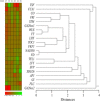Reduction of the geomagnetic field delays Arabidopsis thaliana flowering time through downregulation of flowering-related genes
- PMID: 29709075
- PMCID: PMC6032911
- DOI: 10.1002/bem.22123
Reduction of the geomagnetic field delays Arabidopsis thaliana flowering time through downregulation of flowering-related genes
Abstract
Variations in magnetic field (MF) intensity are known to induce plant morphological and gene expression changes. In Arabidopsis thaliana Col-0, near-null magnetic field (NNMF, i.e., <100 nT MF) causes a delay in the transition to flowering, but the expression of genes involved in this response has been poorly studied. Here, we showed a time-course quantitative analysis of the expression of both leaf (including clock genes, photoperiod pathway, GA20ox, SVP, and vernalization pathway) and floral meristem (including GA2ox, SOC1, AGL24, LFY, AP1, FD, and FLC) genes involved in the transition to flowering in A. thaliana under NNMF. NNMF induced a delayed flowering time and a significant reduction of leaf area index and flowering stem length, with respect to controls under geomagnetic field. Generation experiments (F1 - and F2 -NNMF) showed retention of flowering delay. The quantitative expression (qPCR) of some A. thaliana genes expressed in leaves and floral meristem was studied during transition to flowering. In leaves and flowering meristem, NNMF caused an early downregulation of clock, photoperiod, gibberellin, and vernalization pathways and a later downregulation of TSF, AP1, and FLC. In the floral meristem, the downregulation of AP1, AGL24, FT, and FLC in early phases of floral development was accompanied by a downregulation of the gibberellin pathway. The progressive upregulation of AGL24 and AP1 was also correlated to the delayed flowering by NNMF. The flowering delay is associated with the strong downregulation of FT, FLC, and GA20ox in the floral meristem and FT, TSF, FLC, and GA20ox in leaves. Bioelectromagnetics. 39:361-374, 2018. © 2018 The Authors. Bioelectromagnetics Published by Wiley Periodicals, Inc.
Keywords: Arabidopsis thaliana; delay in flowering time; geomagnetic field; leaves and floral meristem gene expression; near-null magnetic field.
© 2018 The Authors. Bioelectromagnetics Published by Wiley Periodicals, Inc.
Figures





References
-
- Abe K, Fujii N, Mogi I, Motokawa M, Takahashi H. 1997. Effect of a high magnetic field on plant. Biol Sci Space 11:240–247.
-
- Abe M, Kobayashi Y, Yamamoto S, Daimon Y, Yamaguchi A, Ikeda Y, Ichinoki H, Notaguchi M, Goto K, Araki T. 2005. FD, a bZIP protein mediating signals from the floral pathway integrator FT at the shoot apex. Science 309:1052–1056. - PubMed
-
- Andersen CL, Jensen JL, Orntoft TF. 2004. Normalization of real‐time quantitative reverse transcription‐PCR data: A model‐based variance estimation approach to identify genes suited for normalization, applied to bladder and colon cancer data sets. Cancer Res 64:5245–5250. - PubMed
-
- Belyavskaya NA. 2004. Biological effects due to weak magnetic field on plants. Adv Space Res 34:1566–1574. - PubMed
-
- Berr A, Shafiq S, Pinon V, Dong AW, Shen WH. 2015. The trxG family histone methyltransferase set domain group 26 promotes flowering via a distinctive genetic pathway. Plant J 81:316–328. - PubMed
MeSH terms
Substances
Grants and funding
LinkOut - more resources
Full Text Sources
Other Literature Sources
Molecular Biology Databases
Research Materials
Miscellaneous

